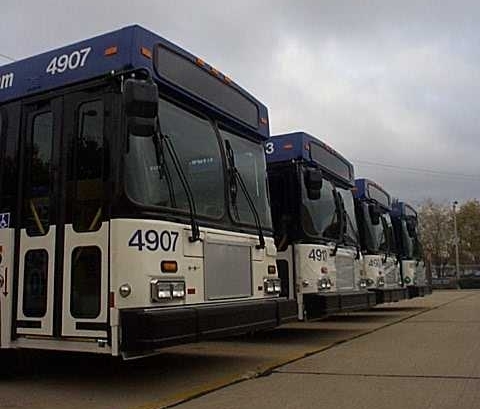Transportation Strategies
Transportation demand management strategies work at reducing Green House Gas (GHG) emissions and Vehicle Miles Traveled (VMT) by influencing healthier individual behavior. These strategies encourage walking, bicycling, and transit as modes of transportation within a community and seek to curb the number and length of trips by vehicles. Transportation strategies also aim to reduce GHG emissions and VMT by improving the overall performance of a transportation system. These strategies improve existing infrastructure, introduce new technology, and plan for the future of the transportation system.
 Bicycle and Pedestrian Programs/Projects
Bicycle and Pedestrian Programs/Projects
• Require bike parking for all new non-residential and multifamily uses.
• Set standards for placement and number (as a function of the intensity of use) for bike parking spaces.
• Make commuter bike routes identifiable and cleared.
• Obtain recognition by the League of American Bicyclists certification.
• Funding and operating for Safe Routes to School SRTS program (or functional equivalent) covering at least 10 percent of students.
• Conduct annual survey of students’ mode of transport to school.
Employer-Based Programs
• Require large employers seeking rezoning to set a price signal (cashout or charge).
• Require large employers seeking rezoning to provide subsidized transit.
• Require large employers seeking rezoning to provide a Transportation Demand Management (TDM) plan that would reduce trips by 20% over “business as usual”.
Traffic Volume
• Track VMT or traffic counts and report on efforts at reduction (including those on this list).
• Eliminate parking minimums from non-residential districts.
• Set parking maximums at X per square feet for office and retail uses.
• Scheduled transit service at basic level (hour peak service within half-mile of 50 percent of addresses).
• Scheduled transit service at enhanced level (half-hour peak service within 75 percent of addresses).
 Preservation and Improvement
Preservation and Improvement
• Develop and fully fund a comprehensive maintenance program for existing roads.
• Charge impact fees for new roads.
• Calculate lane-miles per capita for arterials and collectors, and show reductions.
• Prepare a plan identifying disconnections in bike and pedestrian networks, prioritizing the establishment of new connections and identifying potential funding sources for the most important projects.
• Any proposal to add lanes to a two-lane roadway shall be evaluated for a center turn lane, the preferred option over an expansion to four lanes.
Electric Vehicles
• Allow Neighborhood Electric Vehicles (NEVs) on appropriate roadways.
• Provide public charging stations
Vehicle Idling
• Ban idling (more than 5 minutes) with local government vehicles.
• Ban idling (more than 5 minutes) community-wide.
More Sustainable Communities Strategic Options:
